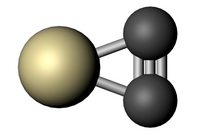|
SiC2 is a cyclic molecule with a fairly low barrier
to linearity which is probably responsible for the large
centrifugal distortion effects, especially in excited
vibrational states involving excitation of v3.
The v3 mode can be considered as asymmetric
SiCC bending motion or as the C2 internal rotation
motion. Ka odd are permitted only
in contrast to Ka even for the ground
vibrational state. This is because of the different vibrational
symmetry.
With respect to the first entry from Aug. 2007/Jan. 2008,
the parameters have been reconsidered, mainly to estimate
transition frequencies for v3 = 3 and 4.
The combined fit is described in
(1) R. C. Fortenberry, T. J. Lee, and H. S. P. Müller,
2015, Mol. Astrophys., 1, 13.
The recently extended set of ground state transition
frequencies was summarized in
(2) H. S. P. Müller, J. Cernicharo,
M. Agúndez, L. Decin, P. Encrenaz,
J. C. Pearson, D. Teyssier, and L. B. F. M. Waters,
2012, J. Mol. Spectrosc., 271 50;
further details can be found there or in the
ground state documentation e052527.cat.
Transitions for v3 = 1 and 2
come mainly from
(3) M. Izuha, S. Yamamoto, and S. Saito,
1994, Spectrochim. Acta A, 50, 1371.
Additional v3 = 1 data were
taken from
(4) M. Bogey, C. Demuynck, J. L. Destombes, and A. D. Walters,
1991, Astron. Astrophys., 247, L13.
Since the data set is fairly small and because of the possible
onset of large amplitude character of the v3 mode
predictions above 500 GHz or with predicted larger than
0.3 MHz should be viewed with great caution.
Transitions with predicted uncertainties larger than
100 MHz have been omitted.
The dipole moment was assumed to agree with that in the ground
vibrational state, see e052527.cat; it is possible that this assumption
is not as good as usually !
NOTE: The partition function takes
into account the ground vibrational state only. However,
contributions of excited vibrational states to
the partitionfunction are available. For corrections
much higher than 200 K, a
list of vibrational energies is also available.
|
